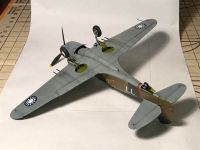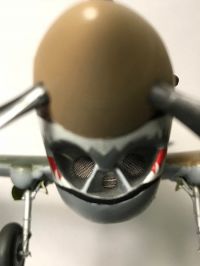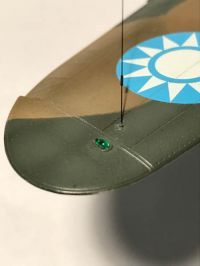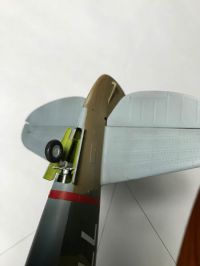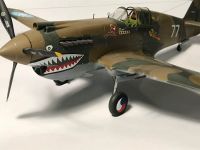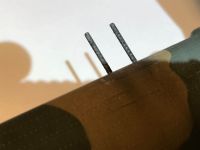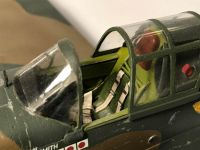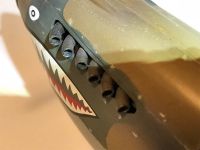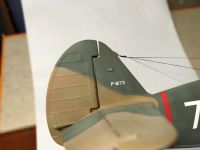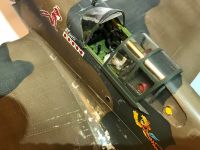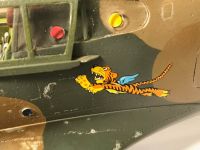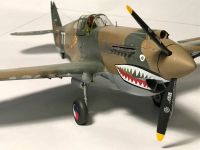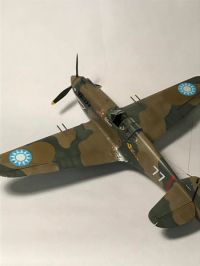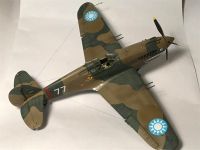Trumpeter 1/32 AVG P-81 (P-40C)
By Russell Bucy
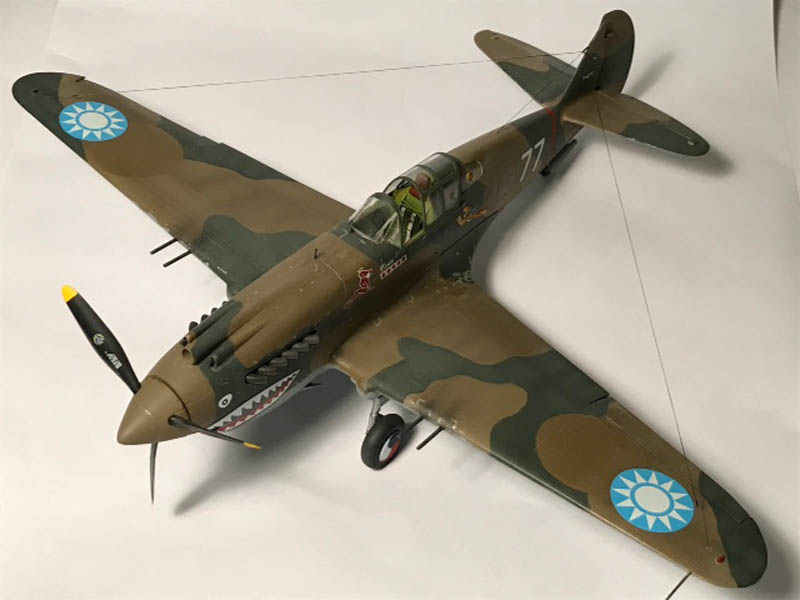
Introduction
Robert Tharp ("R.T.") Smith joined the American Volunteer Group, otherwise known as the "Flying Tigers" in July 1941. Nicknamed "Tadpole" Smith by Tex Hill, another famous early AVG pilot, Smith flew in Burma and China with the AVG until they were disbanded in 1942, and is credited with 9 Japanese aircraft. Lucky for us, Smith is also responsible for providing many of the photos documenting the AVG while they were in Burma in 1941 and 1942. Also known as "Round Trip" Smith after transitioning back into the US Army Air Corps in 1942, he went on to fly P-38s, P-51s and B-25s until the end of the war. In one famous incident, he "accidentally" buzzed Lord Mountbatten when the latter was giving a speech as the Supreme Allied Commander of the CBI (China-Burma-India Theater). During, and after the war, he was a writer and advisor for several radio shows, movies and western serials in Hollywood. He published his own book called "Tale of a Tiger" and wrote articles for "Air Classics". He retired from the Air Force Reserve as a Lieutenant Colonel in 1966. He flew for Trans World Airways, worked for Lockheed as the military sales representative for the F-104, and became a Vice President of Flying Tiger Airlines. Smith died in 1995 at the age of 77—the very number assigned to the Curtiss P-81 he flew while in the AVG.
The P-81-A3 in AVG Service
The "Flying Tigers" are synonymous with the "P-40", but the aircraft flown by the early Flying Tigers was not really a P-40 as much as it was a "hybrid" known by its pilots as the Curtiss Model P-81-A3—a cross between Curtiss's "export" fighter, and the British RAF "Tomahawk" IIB. We call it the "P-40C" here in America, but that's only accurate for the US Army Air Corps designation of aircraft built under Army contract. The P-81-A3s were a "stripped down" version supplied to the AVG. The 100 AVG P-81s delivered in 1941 were originally intended for the British RAF, and were designed to British specifications without gun sights, armament or radios. They were clandestinely "diverted" from the Curtiss (with tacit permission from the British) and delivered to the AVG, who had to assemble and equip them with Nationalist Chinese procured parts. Assembling, maintaining and keeping them in the air proved to be a constant effort, and by some accounts, fewer than 79 of them actually made it into combat. Some of these aircraft were equipped with civilian radios from Piper cub commercial aircraft, and they differed from later models of the P-40 in that the guns were serviced from beneath the wing, which is a detail overlooked in most kits of the famed "Flying Tigers". The three squadrons of Flying Tigers ("Adam and Eves", "Panda Bears" and "Hells Angels") had slight variations in "Shark-mouth" markings and different mascots for each Squadron displayed in different locations on the fuselage. Later, a Walt Disney designed "Flying Tiger" decal was applied to the rear fuselage on some aircraft. R. T. Smith's P-81 (serial P-8173) was number 77. He was a member of the "Hells Angels" Squadron, which had either a standing or seated "red she-devil" displayed on the forward fuselage. We have "Tadpole" Smith's photos, articles and recollections to document many of the aircraft of the AVG, so thanks to him for recording this unique period in aviation history.
Trumpeter's 1/32 P-40C "Tomahawk"
Trumpeter marketed their P-40C in RAF and USAAC boxings, and later their kit was re-boxed (at a lower price point) by HobbyCraft of Canada for a Western Desert Tomahawk IIB or a Flying Tiger P-81. Overall, the kit is accurate in shape, has a detailed engine, and is "mostly" accurate for a P-40B/C, or P-81 with a few modifications. The biggest problem with the kit is the "shallow" cockpit, with incorrect "depth" of the cockpit floor, which in turn makes the sidewalls, seat and instrument panel undersized. The real P-81/P-40B/C used the wing top as the cockpit floor, and was much "deeper" than the kit supplied cockpit. Also for an AVG P-81-A3, the wings have incorrect panel lines depicting the ammunition and gun servicing panels on the top of the wing surface rather than on the underside. Eduard makes a very nice detail set for the Trumpeter Tomahawk kit, which when combined with some simple scratch building, will correct the cockpit issues and add some overlooked detail.
Modifications
- A new cockpit floor was fashioned from sheet styrene at the level of the wings, since the P-81 and P-40 had a one piece wing running through the width of the fuselage (which also contained the fuel tanks, with a prominent fuel gage in the floor as supplied in the Eduard PE set). Replacement cockpit sidewalls were built with Evergreen styrene strip and sheet combined with the Eduard PE items to fill in the additional space created from lowering the new floor.
- The kit seat was discarded (it's too small) and the Eduard P-40 Tomahawk PE detail set was used for the instrument panel, seat, lap belts, sidewall and floor details/controls.
- The prominent fuel filler caps behind and under the left rear cockpit glass were fashioned from punched styrene disks. The kit has the "cut-outs" in place for these, which make the canopy fragile. I managed to break mine which had to be repaired later.
- The top of the wing "gun access panel lines" were filled in with CA, and new rivets were embossed to replace missing rivets in the panel detail of both wings. The lower surface was then engraved to represent the missing gun access panels on the bottom of the wings.
- The kit gun barrels are less than ideal, with no cooling holes. I scrounged four 1/35 scale .30 cal. barrels from a couple of Academy 1/35 M3 Stuart tank kits but there is some debate if the cooling jackets had round openings or early Browning rectangular openings for .30 cal. export weapons.
- The Eduard detail set was used to construct the prominent air filter "cans" at the air intakes at the bottom of the engine cowling, and I took some extra time to drill out and thin the exhaust stacks furnished in the kit. The kit's engine is a nice model in itself, but I usually build my WWII aircraft with cowlings and panels closed--so the engine is in there, it's just not painted or detailed.
- A set of open cowl flaps with their operating mechanism was fashioned from thin brass stock, sheet styrene and wire to depict open cowl flaps. It was a common practice to leave the cowl flaps open in warm climates to aid in engine cooling at start-up.
- Landing gear was detailed with painted copper and brass wire brake lines and gear door opening actuators (there is some debate as to whether or not the AVG P-81s had canvas covers in the main wheel bays or not, so I chose not to depict these).
- I left the flaps closed, since most photos of P-40B/Cs show them that way. Supposedly, the spring loaded flaps closed automatically at engine shut down anyway, as the hydraulic pressure bled off.
Painting
- The model was primed with Alclad gray micro-primer and pore filler, which was polished to a smooth surface with a soft lint-free rag. Selected panels at the wing root and in heavy wear areas were then painted Alclad Aluminum. The rest of the model was pre-shaded with Testor's MM Burnt Umber (I use this a lot for weathering and pre-shading since it's not as "harsh" as flat black). I then airbrushed at least three different shades (lightening each shade with a few drops of white as I went along) of Model Master Olive Green and Earth Brown in the RAF Tomahawk IIB "Europe" camouflage scheme (the diverted P-81s came in this scheme). I worked from the edges of the panels (darker) to the interior of each panel (lighter). This produced a nice weather-beaten and sun-worn looking surface you'd expect in Burma. A small piece of oooo grade steel wool was then rubbed over different panels to remove some of the top coat of paint, exposing the Alclad Aluminum coat beneath. In some areas, a Prismacolor silver pencil was used to simulate "chipping" around individual rivets and panels. Special attention was given to the RAF camouflage pattern, which had a hard edge, and included the "circles" where RAF roundels would have been if the P-81s hadn't been transferred to the AVG. A light coat of "Future" floor polish was applied in areas where decals were to be placed.
- After the painting was done and the decals were applied, exhaust and powder stains were simulated with a combination of burnt umber pastel chalk over a lightly airbrushed "charcoal black" or "lead gray" background. Finally, the model was given a light coat of Testor's Dullcoat, de-canted from the spray can for airbrushing.
Final Finishing Notes
- The decals are a combination of kit decals and Cutting Edge's "Flying Tigers of the AVG" sheet (now OOP), using R.T. Smith's personal markings from early 1942—a red fuselage band, White "77", seated "Hells Angel" an his tally board with his name.
- A P-81 pitot tube was fashioned from brass tube and wire soldered together for strength (I have a habit of breaking these off, so I replace all pitots with brass).
- EZ line antenna rigging was cut to length with painted brass tube insulators to simulate the P-81's three antenna wires (the AVG P-81s came without radios so civilian radios from Piper Cub aircraft were supplied as replacements, but these were not very effective).
This was the first "large scale" model built after I retired from a 30 year active duty career in the US Army. My previous experience had been with the Revell 1/32 scale fighter "collection" (Spitfire, Bf 109, and Stuka) from the 1960s. I'm happy to say a lot has changed in the modeling world in the intervening 50 years since those early Revell large scale models! Finished in 2008, the model sat quietly in my display case for several years while I pursued my "first love" of WWI biplanes. Even with modifications to the cockpit, Trumpeter's kit was an easy build and took me about 50 total hours to complete over a couple of months, which is a "blistering" pace for me. After more than 35 years away from the hobby, it provided an easy transition to get back "into the groove". This was a great model to start with.
References
- "The Curtiss P-40 Tomahawk", Ray Wagner; Aircraft In Profile Publications, Doubleday, 1969.
- "The Role of the Fighter in Air Warfare", James J. Halley; Ziff-Davis Pub., 1978.
- "American Aircraft of WWII", Dave Mondey; Chartwell Books, 1982.
- "The Pacific War", John Costello; Quill Publishers, 1982.
- "The American Fighter Plane", Ted & Amy Williams; Barnes & Noble Books, 2004.
- "The Military History of WWII", Barrie Pitt, Ed.; The Military Press, 1986
- "Aggressors: Interceptor vs. Heavy Bomber", David Anderton & Rikyu Watanabe; Howell Press, 1991.
© Russell Bucy 2018
This article was published on Wednesday, May 30 2018; Last modified on Wednesday, May 30 2018

